the new year. Last year was my 1st NAQP-Cw attempt running QRP. According to the Blog Entry about that GiG, the QRP signal was making the grade, altho the VNC Viewer VPN connection was not. Last year's QSO total was just over 200. The goal for this year was to at least DOUBLE that,
which certainly DID happen.
Having a lop-sided Stereo-Cw facility disrupted the 180-degree spatial listening experience I am
used to during Cw contests - the audio seemed to be "slanted" favoring about 42-degrees to the
left of center in the listening experience. Time for some after-contest audio troubleshooting.
Very prominent in this Cw contest was the large[r] number of stations calling in (often on top
of some other station I called for first) - I send them an exchange only to hear that they have disappeared. As a result, the 1 or 2 more repeats become a waste of EVERYBODY's time
(because the station is already gone). I've mused over the reasons why they frantically call
in and then disappear. The answer was more intricate than can be described in a paragraph
or two. ([CLICK HERE] to read a Blog devoted to that topic).
Being a 12-hour event, there is little opportunity for a "do-over". When the high bands are done,
they are done - there is no "tomorrow" for a second chance. Because single-OPs are only allowed
to operate 10 out of the 12 contest hours, when I am running completely solo the crucial decision
is which 2 hours to hours to NoT operate. A typical compromise is to begin at 19:00 z and end at 05:00z. If things run "perfectly", that makes for a workable compromise. Then again, when things unexpectedly go wrong mid-contest taking me off the air, then of course any time sacrificed near
the beginning can turn out to be an unnecessary precaution.
For this contest weekend, 90-minutes of my off time was spent putting in a shift for the NX6T multi-2 event being run from the remote Anza station. That, coupled with some Stereo-Cw receive audio problems immediately after the contest started, left me with an operating period of exactly 9-hours and 59 minutes (according to the N1MM+ Off-times screen).
Reading some of the after-contest soapbox comments from the SCCC contest reflector, putting
time in on 10-meters early in the contest was a smart accomplishment. When I returned to the band around 13:13 (LocaL), the band was dead, altho amazingly, one lone JA6 station made it into the log. Thanks to the 3-el Stepp-IR yagi configuration, it can be pointed to South America (SA) and then opened up Bi-Directional to work Asia when both are open on 15-meters.
The 2:30pm to 4pm afternoon operating period found me OP'ing STN-2 for NX6T on 10m and mostly 15-meters, while Marko N5ZO mopped-em-u on 20-meters for nearly 10-hours. Resuming WQ6X operations at 00:00z, other than a few gratuitous JA QSOs, 15-meters was all but over, at least
where NAQP was concerned.
The next band pair was 20-40-20-40 and then an "early" LooK at 80-metersa. The goal was to open each band with an S&P run while scouting for a relatively quiet run frequency. Invariably, a non-QRP station will move in barely 100hz away from my run frequency w/o "QRL?" first. When I call them, they come right back to me 1st-time, proving that they COULD hear me all along - they were just
too careless to listen before transmitting - not a good way to "Win Friends and Influence People".
After 04:00z (8pm) 80/40 got very quiet as many single-OPs finished their 10 hours max and shut everything down; either that, or "everybody" left moved down to 160-meters, the only band not yet available at the KN6NBT Ramona QTH.
By the time it was all over it would seem that NX6T took 7th-place overall for Multi-2 while WQ6X
took 3rd-place for Single-OP Assisted QRP. Both stations took a resounding FIRST place West
of the Mississippi.
DiD YOU work the NAQP Cw Contest?
Is WQ6X or NX6T in YOUR LoG?
.Jpg)


.Jpg)
No comments:
Post a Comment